Newsletters
- Home
- Publications
- Newsletter Archive
- Newsletter
September/October 2021
Inside This Issue:
- Survey Provides Insights on Police Chiefs, Departments Serving Rural PA Municipalities
- Chairman’s Message
- Rural Policy Summit: September Summit Focuses on Education, Dates Released for Remaining Sessions
- Center Welcomes New Board, Staff Members
- Rural Snapshot: Census 2020 - Pennsylvania Population Change
- Declining Revenues, Rising Costs Impacting Sustainability of PA Recycling Programs
- Public Hearing Follow-up: OMB to Maintain Current Population Threshold of 50,000
- Just the Facts: Crime Takes a Break
Survey Provides Insights on Police Chiefs, Departments Serving Rural PA Municipalities
Most certified police departments in Pennsylvania serve small and rural municipalities with populations of 10,000 or fewer residents. Since little is known about these departments and their officers, researcher Dr. Jennifer Gibbs of Penn State Harrisburg surveyed Pennsylvania police chiefs in these departments in 2020, through a grant from the Center for Rural Pennsylvania.
A total of 349 (329 municipal and 20 regional) Pennsylvania police chiefs serving municipalities of 10,000 or fewer residents participated in the online survey that was open from June through September 2020.
The research found that in 2020, police chiefs in small and rural Pennsylvania municipalities were mostly non-Hispanic white men who were about 52 years old, with 28 years of policing experience, about nine years of experience as a police chief, and earning an annual salary of $50,000 to $99,999.
Rural police departments had smaller budgets, on average, than urban departments ($525,349 average rural budget and $885,354 average urban budget).
Overall, in 2019, these police departments responded to an average of 4,319 calls for service, dispatching an officer to most of these calls. Rural departments tended to receive fewer calls for service than urban departments.
Small and rural agencies typically provided community services, such as enforcing municipal zoning ordinances and building or property maintenance codes.
More than half of all police chiefs said they lacked adequate technology. More rural chiefs reported they did not have enough technology (60 percent compared to 44 percent of urban chiefs). Less than one third of departments had acquired expensive body-worn cameras. Slightly more than half (53 percent) of departments had car dashboard cameras.
Small and rural police departments also tended to lack enough officers to meet the demand for services, with an average of seven full-time sworn officers and four part-time sworn officers. Some departments were part-time only, with the chief as the only police officer for the municipality.
Over half of departments had a civil service commission to oversee hiring, although urban departments were more likely than rural departments to have a civil service commission. Chiefs reported difficulty in hiring, with small numbers of applicants and fewer academy graduates.
Rural departments were less likely than urban departments to offer mental health services to officers. Police chiefs also said that officers need assurances that seeking help would not jeopardize their careers, and that the stigma associated with seeking help must be removed.
Chiefs reported the most pressing crime problems in their areas to be illicit drugs, domestic violence, and traffic violations. In terms of noncriminal concerns, chiefs reported substance abuse as the top concern facing their communities, followed by an aging infrastructure, lack of youth services, and meeting the needs of older residents.
Policy considerations offered by the respondents were to: provide grant-writing assistance and training for rural police departments, and develop new grant opportunities specifically for small and rural police departments; provide standardized communication throughout Pennsylvania so police can communicate with other emergency service workers on one system and can access records management systems across the state; add or improve towers and repeaters to eliminate dead spots for radio coverage; assist with technology, such as broadband and computers in vehicles; and reexamine civil service requirements to ensure they support recruitment and diversity in policing.
Visit the Center's website for the report, Police Chiefs Serving Small and Rural Municipalities: Profiles and Concerns.
Top Crime Concerns of Rural and Urban Pennsylvania Police Chiefs
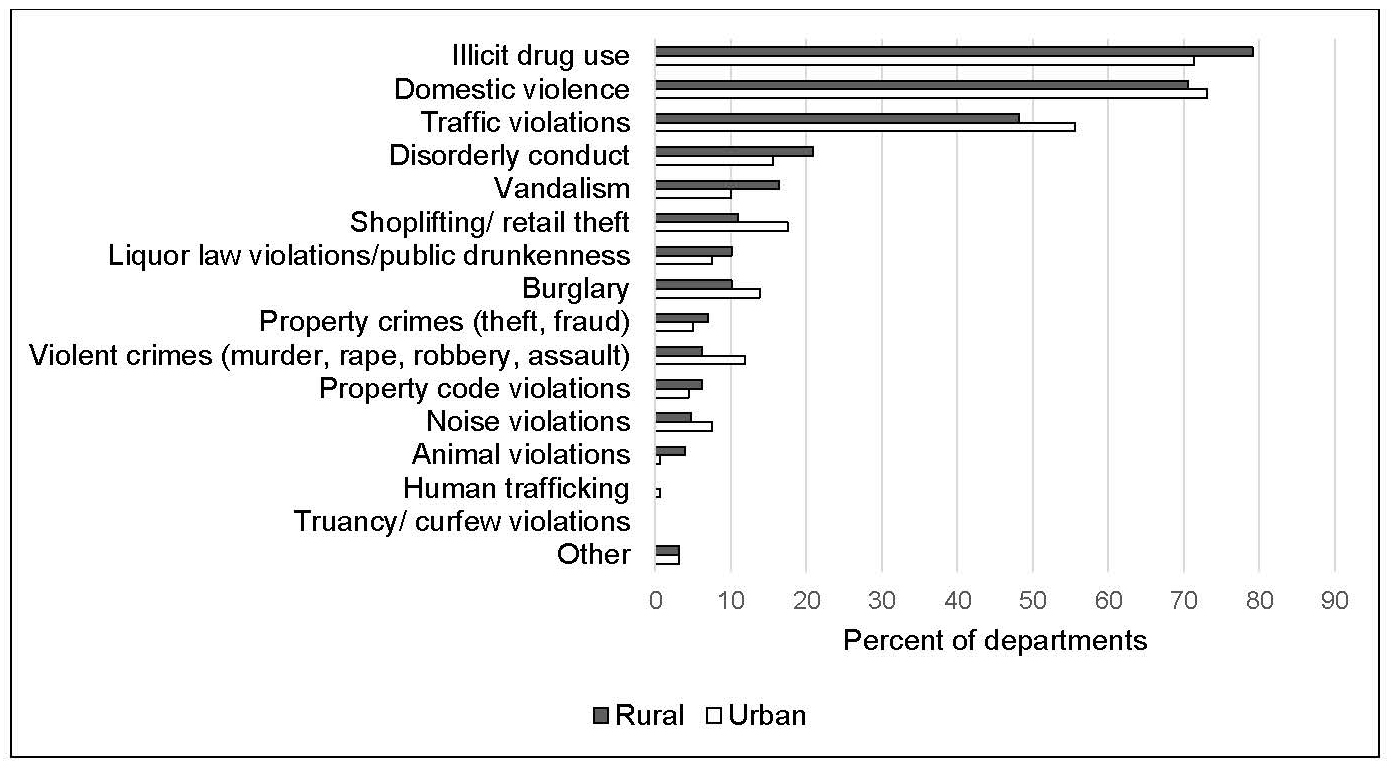
Chairman’s Message
Scary but informative. That’s how I’ll describe the August 24 public hearing on invasive species sponsored by the Center for Rural Pennsylvania. There was talk of gypsy moths, emerald ash borer, zebra mussels, hydrilla, purple loosestrife, and spotted lanternfly. And those were just a few of the invasive species that have been wreaking havoc on Pennsylvania land and waterways – some for decades and others more recently.
In 2019, the Center published two research reports — one on the potential economic impacts of the spotted lanternfly in Pennsylvania and another on legislative and regulatory efforts to control invasive species — both of which noted how invasive species threaten the well-being of our economy, natural resources, and quality of life.
The hearing reiterated those concerns, and it helped us to learn more about potential policy approaches that may be implemented to manage these invasive threats. Each of 10 presenters offered their insights on the damage that invasives have incurred, and more importantly, the actions that have been taken to control invasives in Pennsylvania.
Pennsylvania Secretary of Conservation and Natural Resources Cindy Adams Dunn noted how early detection and rapid response are critical to containing newly discovered invasive species.
Pennsylvania Secretary of Agriculture Russell Redding told of how the reactivation of the Invasive Species Council is helping the Commonwealth develop invasive species action plans. The council is also advising the Governor on invasive species policy development and coordinating interagency response to invasive species threats. However, this may not be enough.
In addition to requesting a dedicated funding stream to manage invasives, Secretaries Redding and Dunn, Pennsylvania Fish and Boat Commission Executive Director Timothy Shaeffer, and many other presenters called for the implementation of a model called Partnerships for Regional Invasive Species Management, or PRISM. This public-private partnership model has a proven track record for helping prevent and minimize the harm caused by invasive species. It’s an approach that may work in Pennsylvania.
Thank you to the following panelists for their participation at the hearing: Secretary Redding, Secretary Dunn, Mr. Schaeffer, Penn State Fruit Research and Extension Center Director Dr. Jayson Harper, Kane Hardwood Resource Manager Thomas Kase, Crawford County Conservation District Watershed Specialist Brian Pilarcik, Shippensburg University Professor Dr. Sara Grove, Pennsylvania Sea Grant Director Sarah Whitney, McKean County Conservation District Communications and Outreach Director Jody Groshek, and New York State Department of Environmental Conservation Invasive Species Coordination Section Chief Josh Thiel.
Click here for the hearing information and a recording link.
Senator Gene Yaw
Rural Policy Summit: September Summit Focuses on Education, Dates Released for Remaining Sessions
On September 15, the Center will hold the second 2021 Rural Policy Summit, which will focus on education. Center Board Vice Chairman Rep. Eddie Day Pashinski will provide opening remarks, and Board Member Susan Snelick will close the session.
The panelists are: Dr. Michael Driscoll, president of Indiana University of Pennsylvania; Joanna Papada, vice president of Government & External Relations, Manchester Bidwell Corporation; Robert Farinelli, vice president of Academic Affairs, Pennsylvania Highlands Community College; and Katharine Pude, superintendent, Bradford Area School District.
The dates and topics of the remaining sessions are:
• October 20 - Health Care;
• November 10 - Local Services & Collaborative Efforts;
• December 8 - Economic Development; and
• January 14 - Agriculture.
The October through December sessions are being held via Zoom. The January session is scheduled to be held in person at the Farm Show Complex.
The Rural Policy Summit series is being cohosted by the Pennsylvania Office of Rural Health, Pennsylvania Rural Development Council, Pennsylvania Department of Community and Economic Development, Pennsylvania Downtown Center, and Philadelphia Federal Reserve Bank’s Community Development and Regional Outreach Department.
Visit the Center’s summit series page for more information.
Center Welcomes New Board, Staff Members

In July, the Center’s Board of Directors welcomed Richard Esch, interim president of the University of Pittsburgh at Bradford and Titusville. Mr. Esch was named interim president on July 1.
He began his career at the University of Pittsburgh in 1994 as the director of auxiliary services. In 1999, he was named chief business and administrative affairs officer and was promoted to vice president for business affairs in 2003. In 2012, he was named vice president for business affairs at Pitt-Titusville.
He has an MBA from the University of Pittsburgh’s Katz Graduate School of Business and a bachelor’s degree from the University of Pittsburgh at Bradford.

In September, the Center welcomed new employee David Martin, public policy data analyst. David assists in the development and analysis of the Center’s database on socioeconomic and demographic factors.
Before he joined the Center, David worked as a data analyst for Baltimore City’s Department of General Services, and as a senior research assistant for the Federal Reserve System’s Board of Governors.
He has a master’s degree in Public Administration from the Fels Institute of Government at the University of Pennsylvania, and a bachelor’s degree in Mathematics and Applied Economics from Ursinus College.
Rural Snapshot: Census 2020 - Pennsylvania Population Change
Data sources: 2000, 2010, and 2020 Censuses, U.S. Census Bureau.
PA POPULATION 2000 = 12,281,054
PA POPULATION 2010 = 12,702,379
PA POPULATION 2020 = 13,002,700
Percent Change in Population by County, 2010 to 2020
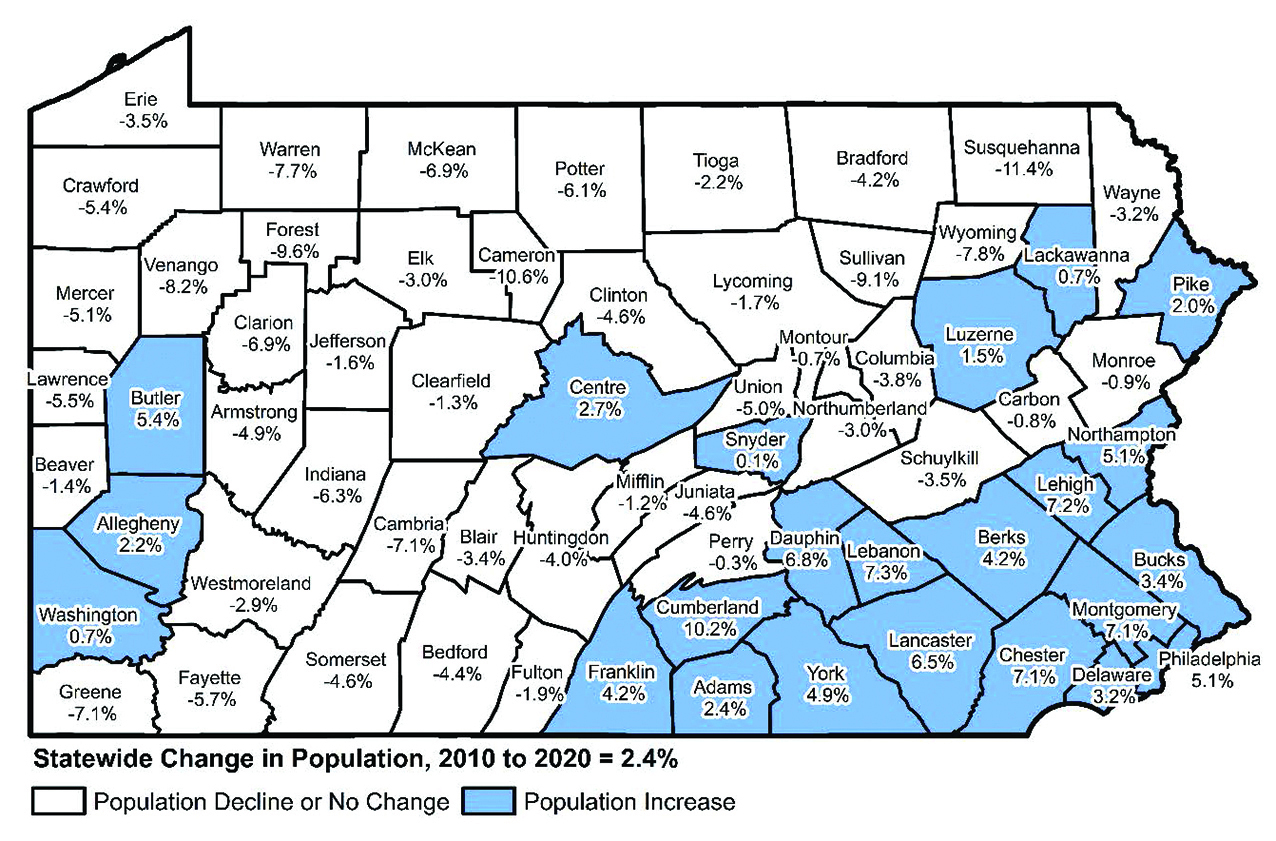
Rural and Urban Population, 1920 to 2020 (In Millions)
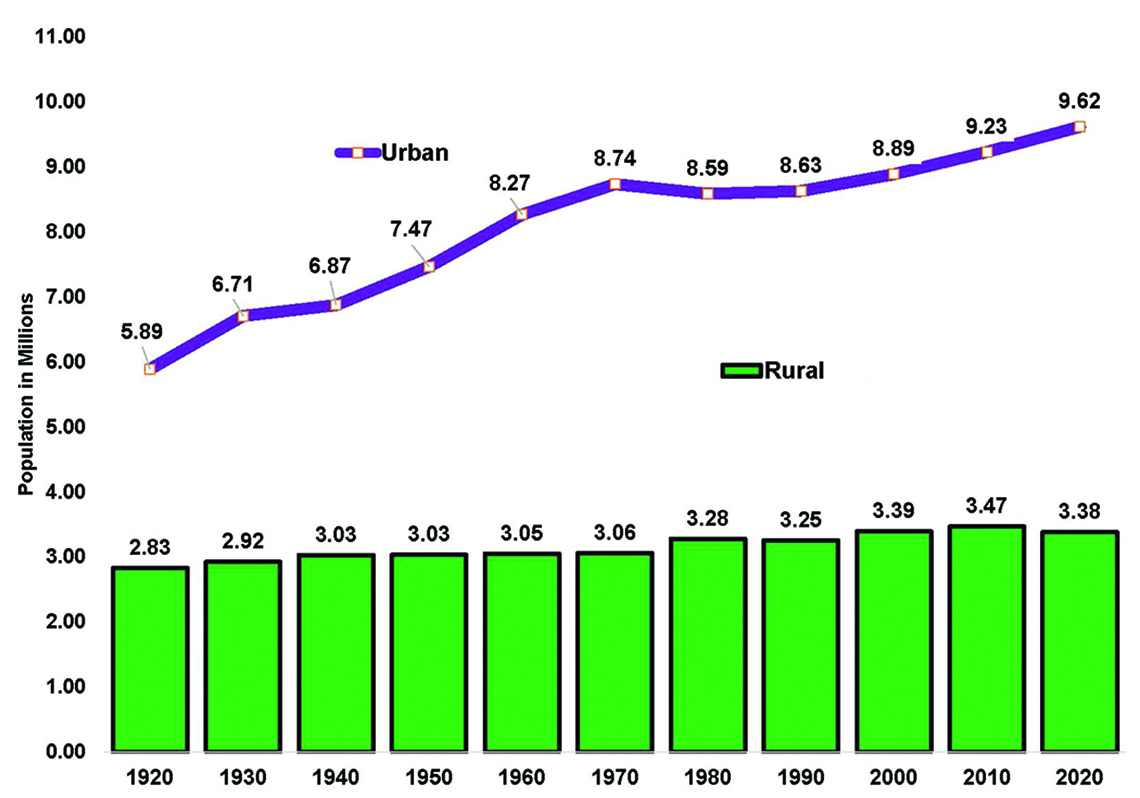
People of Color as a Percent of Rural and Urban Population, 2000, 2010 and 2020
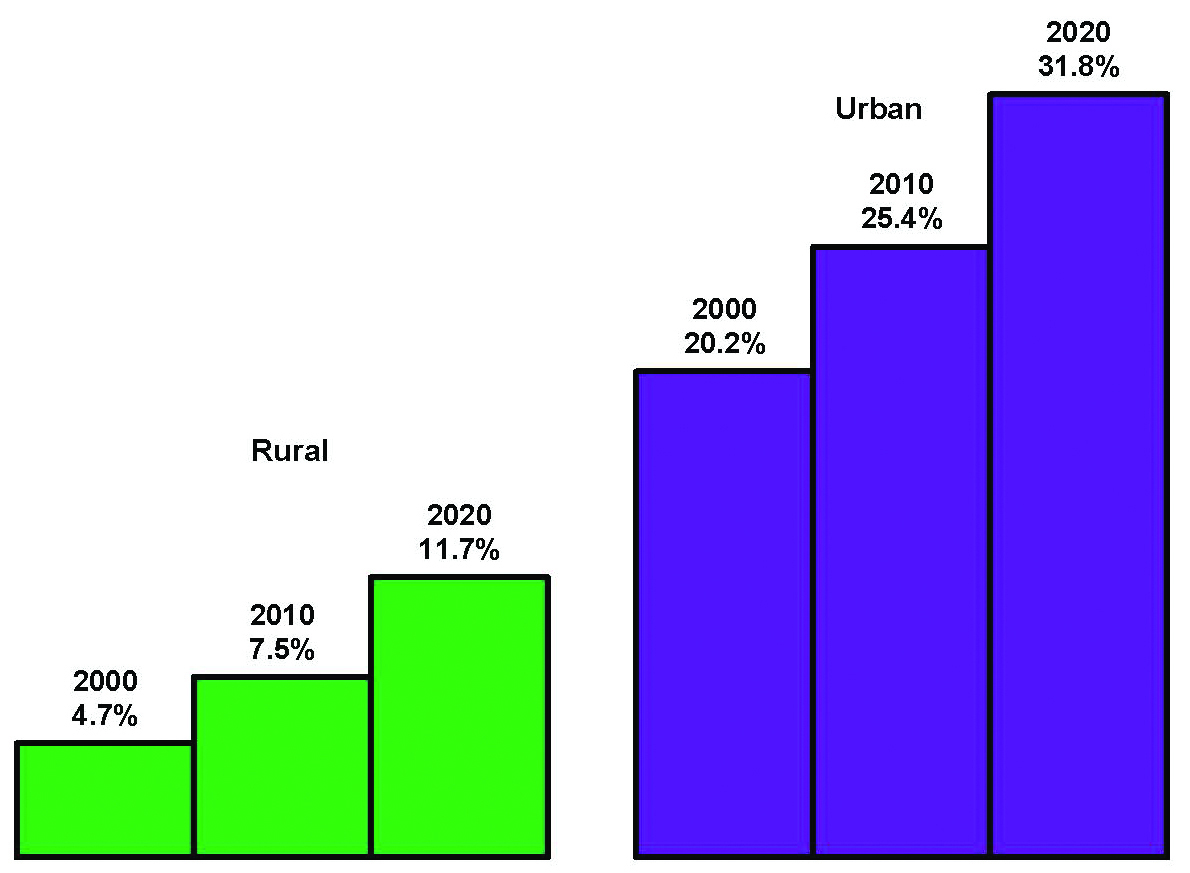
Percent of Population Under 18 Years Old, 2000, 2010, and 2020


Total Number of Rural and Urban Housing Units, 2000, 2010 and 2020
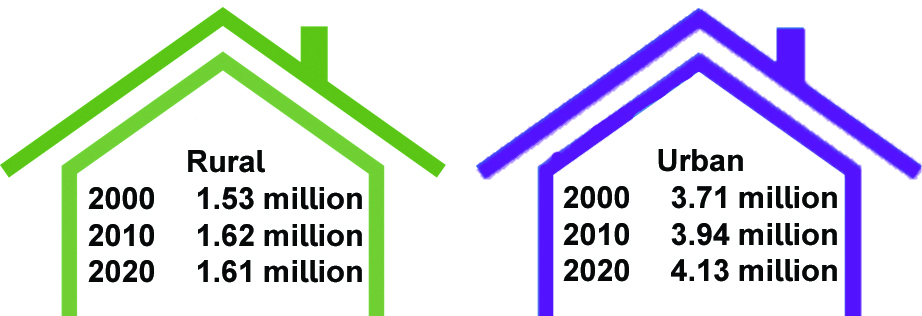
Declining Revenues, Rising Costs Impacting Sustainability of PA Recycling Programs
Recycling programs provide environmental and economic benefits to Pennsylvania, but declining recycling program revenues and rising recycling program costs have been impacting the sustainability of recycling programs statewide, according to research by Dr. Jennifer Haney and Dr. John Bodenman of Bloomsburg University. The research also found that local recycling programs are impacted by global markets and constraints, and that the contamination of recyclable materials has decreased the value of materials collected.
Research Background
The Municipal Waste Planning, Recycling, and Waste Reduction Act of 1988 (Act 101) currently mandates recycling in 475 Pennsylvania municipalities, accounting for 68 percent of Pennsylvania’s residents. More than 586 other municipalities voluntarily have recycling collection programs.
However, in the last several years, increasing costs associated with collection, and decreasing revenues associated with a decrease in the prices received for materials collected in recycling programs, have led to many non-mandated Pennsylvania municipalities to cancel and/or strongly consider suspending their recycling programs.
The research reviewed the status of recycling programs in rural Pennsylvania to better understand the geographic extent and availability of recycling programs and services.
The researchers collected primary data from a web-based survey conducted in 2020 of all Pennsylvania counties that were both mandated and non-mandated to recycle.
They also collected secondary data from the Pennsylvania Department of Environmental Protection’s (DEP) County Recycling Program, which includes both county and municipal data; DEP’s Bureau of Waste Management County Waste Destinations in Tons of Waste quarterly reports for 2010-2019; and the U.S. Census Bureau’s (2018) American Community Survey (ACS) for 2014-2018.
The researchers conducted in-depth case studies on the development and implementation of successful waste management and recycling programs in rural counties.
Research Findings
Overall, the research found recycling programs to be very diverse across the state, with significant differences identified between rural and urban Pennsylvania communities. Both the survey data and secondary data indicated significant variations in programs within a DEP region, within counties, and from municipality to municipality.
The research found that recycling collections are not standardized, with some excluding glass, and others excluding mixed paper, and that collection methods are also very diverse, ranging from source separation to single-stream.
The research suggests that, as recycling programs continue to rely on state funding, it is essential to make recycling a state priority and to replenish the DEP-managed Recycling Fund, established by Act 101, to sustain operations.
Further, survey respondents noted that financial resources are needed to invest in educational campaigns and websites promoting recycling services, particularly in non-mandated rural communities.
Click the title for the report, An Examination of Recycling Programs in Pennsylvania, 2010-2019.
Public Hearing Follow-up: OMB to Maintain Current Population Threshold of 50,000
On July 13, the Office of Management and Budget (OMB) announced that its 2020 Standards for Delineating Core Based Statistical Areas will maintain the Metropolitan Statistical Area (MSA) threshold of 50,000.
OMB will work with the Standards Review Committee to conduct research and stakeholder outreach to inform the 2030 standards update.
In April, the Center’s Board of Directors held a public hearing to learn about the possible funding implications for Pennsylvania if OMB changed its definition of metropolitan areas. The board learned that changing the definition of MSAs could have important financial implications for many Pennsylvania municipalities in terms of federal reimbursements for health care, funding for housing, and investments in transportation.
Here's more information on the hearing.
Just the Facts: Crime Takes a Break
During the pandemic, crime in Pennsylvania took a bit of a break. According to the 2019 and 2020 Uniform Crime Reports from the Pennsylvania State Police, there was a 10 percent decrease in reported crimes in rural Pennsylvania and 13 percent decrease in urban Pennsylvania from 2019 to 2020.
Crime is divided into two types: Part I and Part II. Part I crimes include homicide, rape, robbery, and arson. Part II crimes include fraud, vandalism, and drug abuse violations.
In 2020, there were 154,946 rural offenses reported to the police, or 4,579 reported offenses per 100,000 residents. In urban areas, there were 496,890 offenses reported, or 5,166 offenses per 100,000 residents.
From 2019 to 2020, rural and urban areas each had a 12 percent decrease in Part I crimes. Examples of the declines in rural areas are:
• 16 percent - rape
• 25 percent - burglary
• 17 percent - robbery
• 7 percent - assaults
While the overall rate declined, there were some notable increases in some serious crimes in rural areas including murder (26 percent), arson (29 percent) and motor vehicle theft (5 percent).
Among Part II crimes, there was a 9 percent decrease in rural areas and a 13 percent decrease in urban areas. Some examples of the declines in rural areas are:
• 33 percent - public drunkenness
• 8 percent - fraud
• 16 percent - driving under the influence
• 3 percent - vandalism
Again, while the overall rate declined, there were some notable increases in Part II crimes in rural areas including offenses against the family and children (5 percent), drug abuse violations (possession/sales) (2 percent), and weapons (carrying/possessing violations) (12 percent).
At the county level, five counties saw a 20 percent or more decrease in the number of Part I and Part II crimes: Centre, Clearfield, Indiana, Lackawanna, and Lebanon. Eleven counties saw an increase in crime, with five counties having an increase of 8 percent or more: Armstrong, Juniata, Perry, Potter, and Susquehanna.
